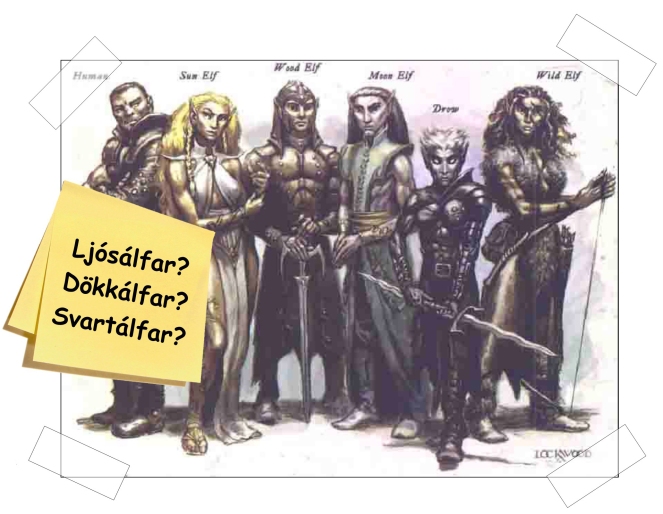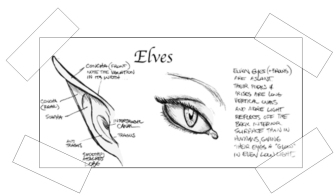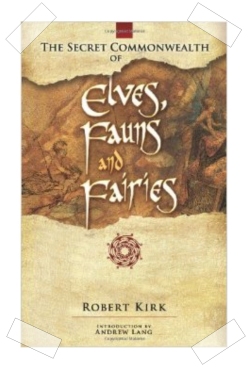 The Elves
The Elves
By Steven A. Guglich
Everyone has their own ideas about what an elf is or what an elf looks like. There are the staunch believers that say the only true elf is the Tolkien elf! Girls swoon at the mention of the name Legolas. Some believe that elves have to be tall and powerful. Others say they  are short and cute. There are many who envision elves from any number of Christmas movies. And others who associate them with cookies. For a large number of people their understanding of elves is based on the popular role-playing games, Dungeons & Dragons. And yet, there are some who have little knowledge of what an elf is— nor do they care.
are short and cute. There are many who envision elves from any number of Christmas movies. And others who associate them with cookies. For a large number of people their understanding of elves is based on the popular role-playing games, Dungeons & Dragons. And yet, there are some who have little knowledge of what an elf is— nor do they care.
The truth of the matter is that elves are one of the most iconic and familiar fantasy races of all time. Some might say, we’ve had enough of the elves. So why would I waste my time on a race that has become so overused? So iconic? Well, The Veil Saga is all about those myths and legends that have shaped our world for centuries. The elves that inhabit this fictional world have a rich history that dates back many millennia. And each part of their history can be found in the mythology and legends we know today. I could not tell the stories of The Veil Saga without the elves.
 To understand their role in the story we need to start at the beginning. Like the dweorg, we need to look back to Old Norse mythology. Before they were known as elves, they were called the ljósálfar, dökkálfar, and svartálfar. Three types of elves (alfar in the Old Norse means elf), all with an air of mystery surrounding them.
To understand their role in the story we need to start at the beginning. Like the dweorg, we need to look back to Old Norse mythology. Before they were known as elves, they were called the ljósálfar, dökkálfar, and svartálfar. Three types of elves (alfar in the Old Norse means elf), all with an air of mystery surrounding them.
 The ljósálfar, were the Light Elves of Norse Mythology. Curiously, little is actually recorded about them. They were luminous beings, “more beautiful than the sun,” from the realm of Alfheim. And that is all that is written in the texts of Old Norse Mythology. Their story, however, does not end there.
The ljósálfar, were the Light Elves of Norse Mythology. Curiously, little is actually recorded about them. They were luminous beings, “more beautiful than the sun,” from the realm of Alfheim. And that is all that is written in the texts of Old Norse Mythology. Their story, however, does not end there.
In contrast to the Light Elves, were the dökkálfar, the dark elves. All that is known of them is that they were “pitch black”, evil, and they lived underground. But what of the svartálfar? Their name means “black elves”. How are they any different from the dökkálfar? According to most scholars, the term svartálfar came later in Norse Mythology and it does not even apply to elves, but to the dwarves (dweorg). Tradition would have us believe there were only two kinds of elves, dökkálfar and ljósálfar. So why did Snorri Sturluson, the scribe of many of the Norse Mythologies, sometimes refer to the dwarves as svartálfar? According to Lyonel Perabo, expert in Old Norse Religion, Tourist Guide in the Arctic and writer at The Wildhunt, we probably will never know. But Perabo does have a theory.
“Well, to start with, Snorri Sturluson’s main goal in writing his Prose Edda was not to give a truthful and genuine account of the beliefs, practices and worldview of the Pagan Norsemen of old, but rather to present the old myths of the Norse poetic arts (skaldic poetry) in a systematic and easy-to-understand way. Snorri, who knew about at least some of Classical mythology likely wished to stitch together unclear or contradictory stories best he could and likely was influenced by both Classical tales and Christian writings.”
 Classical tales and Christian writings? Yes! Stories of the alfar and dweorg did not die with the Old Norse and the Vikings. Their tales influenced much of the old world, including Christian beliefs. There were some who believed that the elves were angels and others who believed them to be demons. Others even claimed they were the children of Adam and Eve.
Classical tales and Christian writings? Yes! Stories of the alfar and dweorg did not die with the Old Norse and the Vikings. Their tales influenced much of the old world, including Christian beliefs. There were some who believed that the elves were angels and others who believed them to be demons. Others even claimed they were the children of Adam and Eve.
Over the centuries, tales of the alfar spread from Scandinavia to the Anglican countries and the name alfar came to be known as aelfe, and then eventually elf. The term elf can be synonymous with any mysterious, magical creature. Scholars characterized them by behavior and began to call them by names according to their classification. Pixies, fairies, wights, brownies, and the list goes on. But they were all still elves.
Stories of sightings and encounters became legends and fairy tales. Some tales tell of the good deeds the elves have done, while others tell tales of abduction, mischief, and murder. In some legends, the elves are called fairies. Even still, others use the term elf, fairy, dwarf, and gnome interchangeably. Over the last century the concept of elves has changed even more.
 Christmas elves came on to the scene in the 19th century and began to shape humanity’s view of elves even more. And finally, the single most important addition to elven lore came from none other than a British writer named J.R.R. Tolkien. His creation of the elves of The Lord of the Rings became the most prevalent view of the modern fantasy fiction elf.
Christmas elves came on to the scene in the 19th century and began to shape humanity’s view of elves even more. And finally, the single most important addition to elven lore came from none other than a British writer named J.R.R. Tolkien. His creation of the elves of The Lord of the Rings became the most prevalent view of the modern fantasy fiction elf.
In a recent poll I conducted on Facebook, I asked people to quickly name the first elf that came to mind. The most popular was that of Legolas; no doubt because of Orlando Bloom’s portrayal of the legendary elven archer on the big screen. The second most popular answer showed the popularity of the Christmas elf. I received several different names of elves found in numerous Christmas stories.
Whether you think they have lost their place in fantasy fiction or simply that they are overused, the point is they are there and they have shaped fantasy fiction for what it is today. How could I not have the elves play a central role in a series that relies so heavily on the popular understanding of mythological creatures and legends?
The history of the elves featured in The Veil Saga is rich and long. Thousands of years before the humans came into the world, the elves and their enchanted brethren warred with another and learned the value of peace. When the humans finally came on the scene, the elves interacted with them. Cultures in the middle east, the Mediterranean, and even the orient were influenced by the elves. However, when the elves saw humanity’s penchant for conquest, they and the other enchanted races hid themselves behind the Veil. Many of the myths and legends of today were perpetuated by elves who temporarily left their commonwealths and the protection of the Veil for one reason or another.
 Living in the shadow of humanity has caused curiosity among many elves. Stories of man’s rapid development and expansion were abundant and many elves were not content with just hearing the stories. In the old days, not long after the raising of the Veil, a tradition began among the adolescent and immature elves. Their curiosity led them on adventures into human settlements. The elves would remain hidden. Some would simply observe. Others would cause mischief. And then there were those who were driven to do more.
Living in the shadow of humanity has caused curiosity among many elves. Stories of man’s rapid development and expansion were abundant and many elves were not content with just hearing the stories. In the old days, not long after the raising of the Veil, a tradition began among the adolescent and immature elves. Their curiosity led them on adventures into human settlements. The elves would remain hidden. Some would simply observe. Others would cause mischief. And then there were those who were driven to do more.
Their immaturity led to malice for some and a desire to help for others. In one such account, three adolescent elves left the confines of the Veil and came across a poor  German cobbler and his wife. Out to cause mischief, they overheard the cobbler offer to give another poor man the last pair of shoes they had in the store. The cobbler and his wife were unsure how they will survive with no inventory to keep their shoppe running. The elves were moved by the cobbler’s kindness. That night, as the humans slept, the elves used their resources, their magic, and their craftsmanship to restock the cobbler’s inventory. Hundreds of miles away, in Scotland another group of elves left the confine of the Veil. These elves, however were not adolescents and they were not out for mere mischief. A rogue group of dark elves defied the Veil Accord and entered the human lands. Fed up with the humans encroaching ever so close to their commonwealth, a dark elf named Sith iyl Sudal lead a small army across Scotland and into Ireland. They rode on the back of elven hounds and attacked many towns and villages along the way. Some were full scale assaults while others were night time raids. When the Elven Council of Elders got word, they put a stop to Sith’s attacks. But not before it was too late.
German cobbler and his wife. Out to cause mischief, they overheard the cobbler offer to give another poor man the last pair of shoes they had in the store. The cobbler and his wife were unsure how they will survive with no inventory to keep their shoppe running. The elves were moved by the cobbler’s kindness. That night, as the humans slept, the elves used their resources, their magic, and their craftsmanship to restock the cobbler’s inventory. Hundreds of miles away, in Scotland another group of elves left the confine of the Veil. These elves, however were not adolescents and they were not out for mere mischief. A rogue group of dark elves defied the Veil Accord and entered the human lands. Fed up with the humans encroaching ever so close to their commonwealth, a dark elf named Sith iyl Sudal lead a small army across Scotland and into Ireland. They rode on the back of elven hounds and attacked many towns and villages along the way. Some were full scale assaults while others were night time raids. When the Elven Council of Elders got word, they put a stop to Sith’s attacks. But not before it was too late.
Now, the question for you dear readers, is how much of that did I actually make up and how much of it comes from fables, legend, and mythology?
 The story of The Elves and the Shoemaker by the Brothers Grimm is an old tale published in 1812 and pretty much follows the above re-telling with the exception of the elves leaving the Veil.
The story of The Elves and the Shoemaker by the Brothers Grimm is an old tale published in 1812 and pretty much follows the above re-telling with the exception of the elves leaving the Veil.
The story of the dark elves known as Sith is far more intriguing (in my opinion). (Yes, that’s right… they were called sith. Makes you wonder if this is where George Lucas got his inspiration.) Legends and tales of the demon sith and their dogs known as cu sith, were popular in Scotland and Ireland in the 1600s. In fact, a Scottish minister named Robert Kirk went all over the Highlands interviewing people about their encounters. His notes were published as a book in the late 1800s. The book is called “The Secret Commonwealth of Elves, Fauns, and Fairies.” The book itself is interesting, but difficult to read, because it is in the language of the 16th century. In his writings, Reverend Kirk details interviews of people who encountered the sith and lived. He states these survivors have “second sight” because they saw what no man had ever seen. Strangely enough, even though Kirk interviewed several people who had unpleasant experiences with the sith, he considered the sith to be a good race of beings. Some even believed that the good reverend himself had “second sight.” Even stranger though is that at the age of 42, the reverend was found dead one morning, wrapped in his robes and spread-eagle against a hill. Legend states that it was the sith who killed him because he had gotten too close to their commonwealth.
of Elves, Fauns, and Fairies.” The book itself is interesting, but difficult to read, because it is in the language of the 16th century. In his writings, Reverend Kirk details interviews of people who encountered the sith and lived. He states these survivors have “second sight” because they saw what no man had ever seen. Strangely enough, even though Kirk interviewed several people who had unpleasant experiences with the sith, he considered the sith to be a good race of beings. Some even believed that the good reverend himself had “second sight.” Even stranger though is that at the age of 42, the reverend was found dead one morning, wrapped in his robes and spread-eagle against a hill. Legend states that it was the sith who killed him because he had gotten too close to their commonwealth.
Mythology, fables, tales and legends gave me an almost endless source of history to bring the elves into the 21st century. Imagine if the elves were alive and well today? What would their cities be like? What would their culture be like? How advanced would their technology be?
It is my hope that you will continue with me on this journey and discover for yourself just who the elves of The Veil Saga really are.
Great article Steve. I love how rich of a world you are building. Though, I’m not sure you will ever convince me that pointed shoes are cool! LOL
Where did you find that artwork? Its awesome.
LikeLiked by 1 person
Great blog once again – thanks!
LikeLiked by 1 person
I love this! So much information, I had no idea elves had such a history. And it was fascinating because I love to learn new things. Very wonderful research you have here, Steve. I’d love to keep following the history and where you created your characters. xo
LikeLiked by 1 person
Thank you! It is amazing how mythology has evolved over the centuries ! And it has been exciting to be able to use that as a part of The Veil Saga.
LikeLiked by 1 person
I’m looking forward to your books. Do you have much of them written already?
LikeLiked by 1 person
I have the first one half way written. But I have put that to the side for now as I do so heavy world building. I have three more races to go before I get back to the first book.
LikeLike
I love this blog series 😀
LikeLiked by 1 person
Thank you!
LikeLike